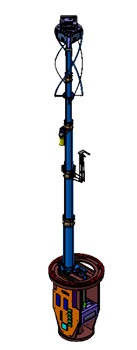
Meteorological Boom and Antenna
The Meteorological boom provides supports and attachment points at a sufficient height from the surface for the
PanCam - Panoramic Camera,
MetHumi - Humidity Instrument,
MetSIS - Solar Irradiance Sensor,
Temperature sensors.
The boom is manufactured from a carbon composite (ceroplastic) to ensure a minimum structural weight. It consists of three joints, which are stacked inside the Shock Absorption System (SAS) container during flight, entry, descent and landing. After landing and SAS vertical orientation the boom is deployed with a command from the probe control system. The boom is hollow and and the necessary cabling for the sensors and the antenna are run inside the boom, which hence also provides mechanical protection for the cables during deployment and operations. The length of the boom is 90cm and the boom is covered with white dim enamel ensuring specific optical properties to achieve minimal radiation overheating and disturbance of meteorological measurements. The deployment mechanism consists of springs with clampers, which provide rigidity for the structure after deployment. The temperature sensors are on special brackets on the distance more than 10 diameters of the boom to lower the influence of the boom. Special vertical orientation is not stipulated.
Antenna
The antenna of the MetNet Lander is a variant of the asymmetrical dipole antenna with a coaxial feed line. The antenna has bee attached to the meteorological boom.
One of the main advantages of such type of antenna is the weak dependence of the antenna impedance on the physical parameters of the surface at the landing site. Since the antenna has vertical polarization it has the smallest gain along the dipole.



